Zeno trap
Quadrupole time-of flight instruments most commonly use the orthogonal injection of ions coming from a quadrupole collision cell into the flight tube region, because this configuration maximizes TOF resolution, mass accuracy, and sensitivity for an entire spectrum without the need for scanning. This type of ion pulsing, however, suffers from a relatively low duty cycle. Typically, only 5-25% of ions are ejected with each pulse of the accelerator, depending on the geometry and m/z range. This is not usually an issue in the MS1 dimension, because the ion current as generated by modern sources (such as the Turbo V ion source), and transmitted by modern ion capture technology (such as the QJet ion guide), results in ion currents that need to be reduced to prevent saturation and to protect the longevity of TOF MS detectors. In the MS/MS dimension, however, an improvement in the duty cycle can lead to significant gains in sensitivity.
The ion losses are a result of the drift region between the collision cell and the TOF accelerator. This region behaves as a crude TOF separation, where low m/z ions migrate faster than high m/z ions and, as a result, a significant fraction over or under migrate to the accelerator region and are lost with each pulse. Previously, there have been many attempts to overcome this lack of synchronicity. It has only been achieved, however, either for narrow mass ranges or at low acquisition frequency.
Use of the Zeno trap overcomes these technological barriers to recover duty cycle losses across the entire m/z at up to 100 Hz acquisition frequency. This is achieved using a linear ion trap, referred to as a Zeno trap, at the exit of the collision cell. The mechanism of trapping and releasing ions is highlighted in Figure 2. Ions enter the ion trap and are contained with potential barriers on the ZG and IQ3 lenses, while subsequent packages of ions are accumulated in the LINAC collision cell, preventing ion loss. The trapped ions are left to energetically cool and are subsequently released based on potential energy resulting in an ordered release generally ranging from high m/z to low m/z. In this way, each ion across the mass range reaches the center of the TOF accelerator simultaneously.
This simple trapping and releasing mechanism leads to significant gains in MS/MS sensitivity, as highlighted in Figure 3. MS/MS with the Zeno trap activated results in a 4- to 15-fold (or greater) gain in signal, with increased gains at low m/z fragments. The Zeno trap efficiency combined with precise ion-release timing yields ≥90% of the theoretical gain across the entire mass range. Due to the degree of selectivity afforded with high resolution MS/MS data, these improvements in signal are combined with negligible changes to noise, resulting in spectral and chromatographic signal-to-noise on the order of the gains observed in raw signal (Figure 4, 5).
These improvements in MS/MS sensitivity not only have the ability to drastically improve LOQs for quantitative assays, but this additional sensitivity can be used to revolutionize entire workflows. With the Zeno trap activated, high-quality MS/MS spectra can be used for confirmation, identification, or library matching at much lower mass loading. This gives the ability to significantly dilute precious samples and improve ionization efficiency by minimizing matrix effects and improve instrumental robustness with lower mass loading. At the same sample loading, MS/MS with the Zeno trap on yields greater confidence in identifications while allowing for the ability to discover new metabolites, peptides biomarkers and contaminants at lower concentrations than ever before.
Precisely tunable electron activated dissociation (EAD) cell
Tandem mass spectrometry is dominated by collisional induced dissociation (CID) that generates ion fragments for quantification and identification of molecular species. With CID, ions are generated in an accelerated cell filled with a neutral gas species promoting molecular collisions that result in bond cleavage, typically at the most labile sites. Although fast and efficient, CID can often result in few diagnostic fragments that are insufficient to elucidate structural information from unknown features or to differentiate isomeric species.
Electron activated dissociation (EAD), conversely, describes a family of free electron-based dissociation mechanisms characterized by the charge state of the precursor ion and the kinetic energy of the electron beam. EAD mechanisms are known to give complementary information to CID. The extent and location of bond cleavage differs for radical (EAD) and thermal (CID) techniques.
The ZenoTOF 7600 system features the EAD cell, a new electron beam optic design that simultaneously and independently traps precursor ions and free electrons for efficient radical fragmentation. With the EAD cell, the system has the ability to tune electron energies above zero, which opens up radical fragmentation to applications beyond biomolecules. Tunable electron kinetic energy from 0-25 eV provides access to different fragmentation regimes (Figure 6), including electron capture dissociation (ECD), hot ECD, and electron impact excitation of ions from organics (EIEIO). These advances enable fast, precise and quantitative dissociation of various analytes ranging from singly charged small molecules to multiply protonated proteins. Also, at higher energies, reaction times are reduced allowing for these dissociation techniques to be used on a chromatographic timescale. It is the combination with the Zeno trap that allows EAD to now have the sensitivity and specificity needed for routine use.
ECD and hot ECD for multiply charged peptides, proteins and biotherapeutic molecules
Post-translational modifications (PTMs) are widely important for various protein functions, including protein conformation, signaling and activity. Some PTMs can be difficult to characterize using mass spectrometry, however, when they are labile, CID is used as the dissociation technique. Radical dissociation techniques have the ability to maintain these PTMs, which allows for peptide backbone mapping, while simultaneously elucidating the identity and location of the PTM. Figure 7 shows the example of a phosphorylated peptide, LITV, using hot ECD (KE = 7 eV). Here, not only is nearly the entire peptide sequenced with hot ECD, but the location of the phosphorylation is maintained.4
Electron impact excitation of ions from organics (EIEIO) for singly charged molecules
Having the ability to tune electron kinetic energies in the 5 to 15 eV range opens up EAD to the realm of singly charged molecules. Electron capture, resulting in neutralization, is reduced at this kinetic energy, allowing the electrons to induce dissociation through radical mechanisms. Figure 8 shows the comparison between CID and EIEIO for the fragmentation of a sphingomyelin lipid species. EIEIO gives spectral information for nearly every bond to elucidate head group identity, backbone type, carbon chain lengths, double bond positions and double bond stereoisomerism. In a similar fashion, EIEIO can be used to differentiate between isomers of small molecules. Figure 9 highlights the unique, characteristic fragment for O-glucuronide conjugated darunavir compared to its N-glucuronide isomer, allowing for more precise molecular information within metabolite identification workflows. EIEIO fragmentation also opens up additional specificity for non- targeted and suspect screening workflows. Figure 10 highlights the difference between EIEIO and CID for the fragmentation of azoxystrobin, a fungicide. The CID spectrum is dominated by two main fragments, whereas the EIEIO spectrum contains over 200 peaks with S/N >10, which allows for significantly improved confidence during library matching and structural elucidation.
Linear dynamic range (LDR)
LDR is important in many applications where the analyte concentration varies widely. The ZenoTOF 7600 system is equipped with a 4-channel MCP detector with ADC signal processing, resulting in greater than 5 orders of inter-scan linear dynamic range in both positive and negative ion modes, and for both MS and MS/MS acquisitions (Figure 11). Further, the ADC detector is capable of 4 orders if intra-scan linear dynamic range, allowing for the simultaneous detection of both high and low level analytes without a loss of data quality.
Acquisition speed
The ZenoTOF 7600 system comes equipped with a high-speed LINAC collision cell that allows for fast acquisition rates, suitable for highly multiplexed experiments and rapid LC separations. Combined with the high speed of the MCP detector, the ZenoTOF 7600 system is capable of >100 Hz acquisition rates, with accumulation times as low as 5 msec, without sacrificing mass accuracy and resolution. Figure 12 highlights the maintenance of mass accuracy, mass resolution and peak intensity across a range of accumulation times.
OptiFlow Turbo V ion source for low flow chromatography
The ZenoTOF 7600 system has the option for the OptiFlow Turbo V ion source, which is designed for microflow and nanoflow chromatography (Figure 13).5 Probe and electrode combinations are pre-optimized for sensitivity and robustness from 0.1 to 200 µL/min. This means no manual adjustments are needed to maximize performance. SecurityLink tubing and fittings are used such that all fittings are finger tight, leak free and have zero dead volume. For microflow chromatography, the exit of the column connects directly to the electrospray probe, minimizing post-column broadening for enhanced S/N. The instrument comes configured with the OptiFlow interface, so switching between high flow or microflow to nanoflow is a toolless change, without the requirement of breaking vacuum on the system.
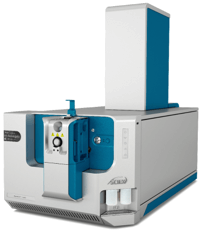
 Click to enlarge
Click to enlarge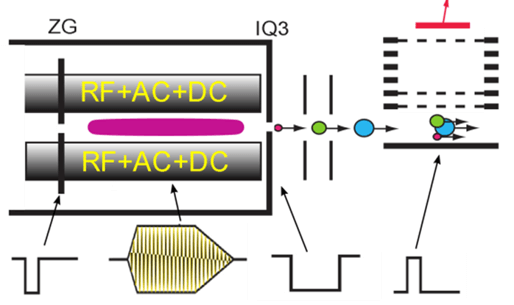 Click to enlarge
Click to enlarge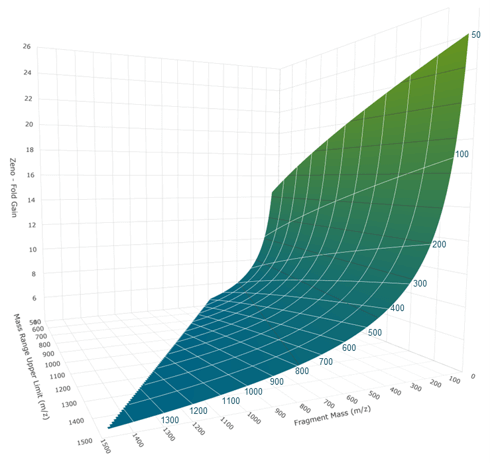 Click to enlarge
Click to enlarge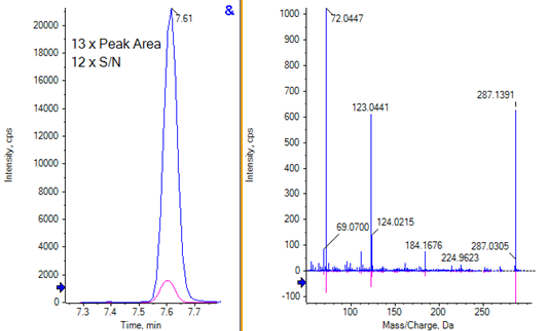 Click to enlarge
Click to enlarge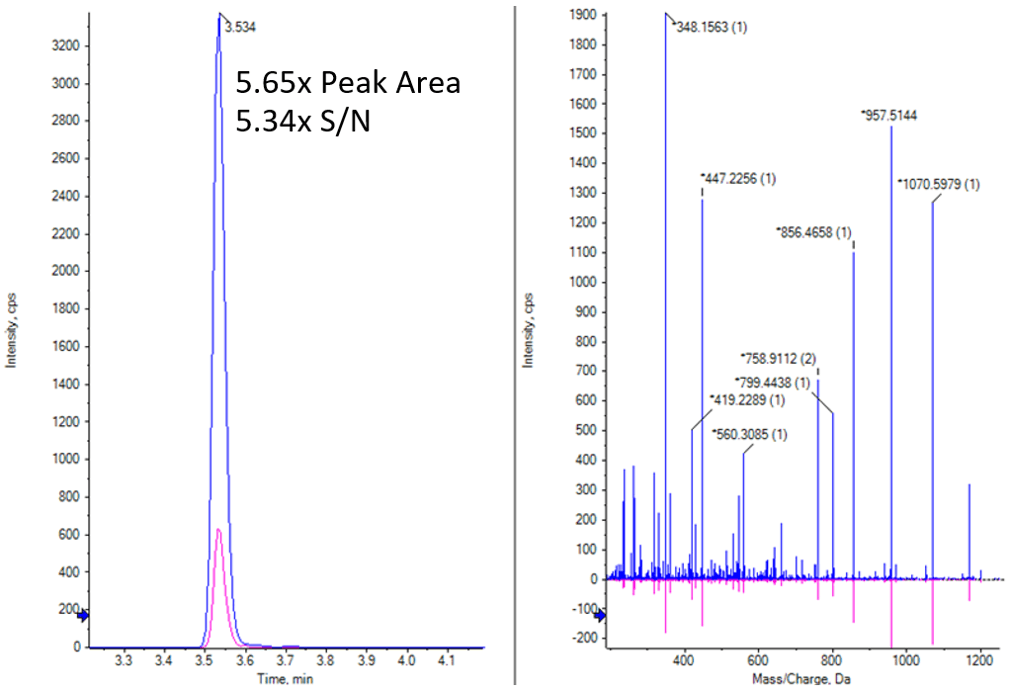 Click to enlarge
Click to enlarge Click to enlarge
Click to enlarge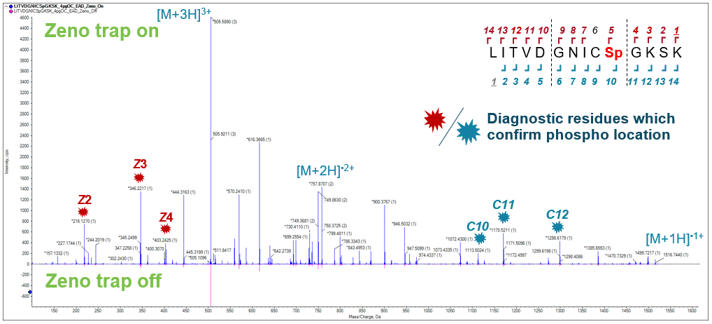 Click to enlarge
Click to enlarge Click to enlarge
Click to enlarge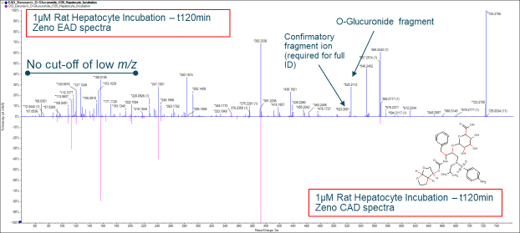 Click to enlarge
Click to enlarge Click to enlarge
Click to enlarge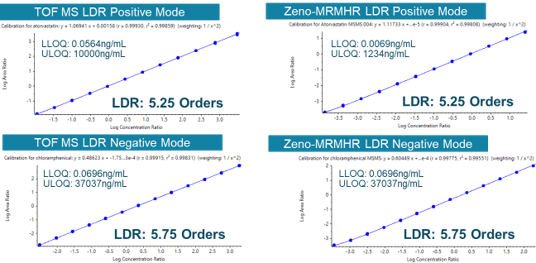 Click to enlarge
Click to enlarge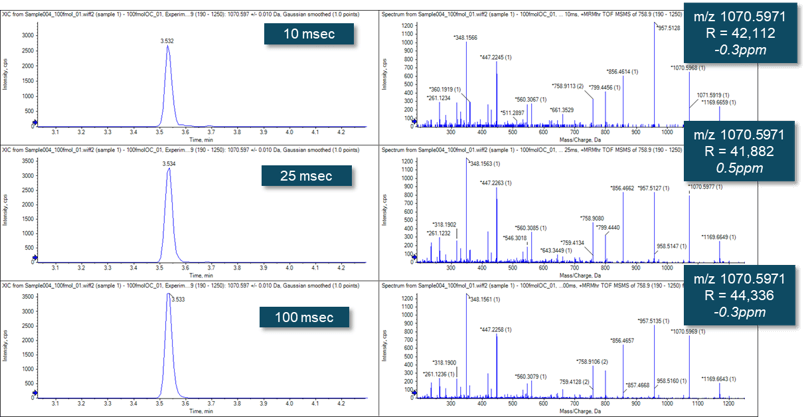 Click to enlarge
Click to enlarge Click to enlarge
Click to enlarge